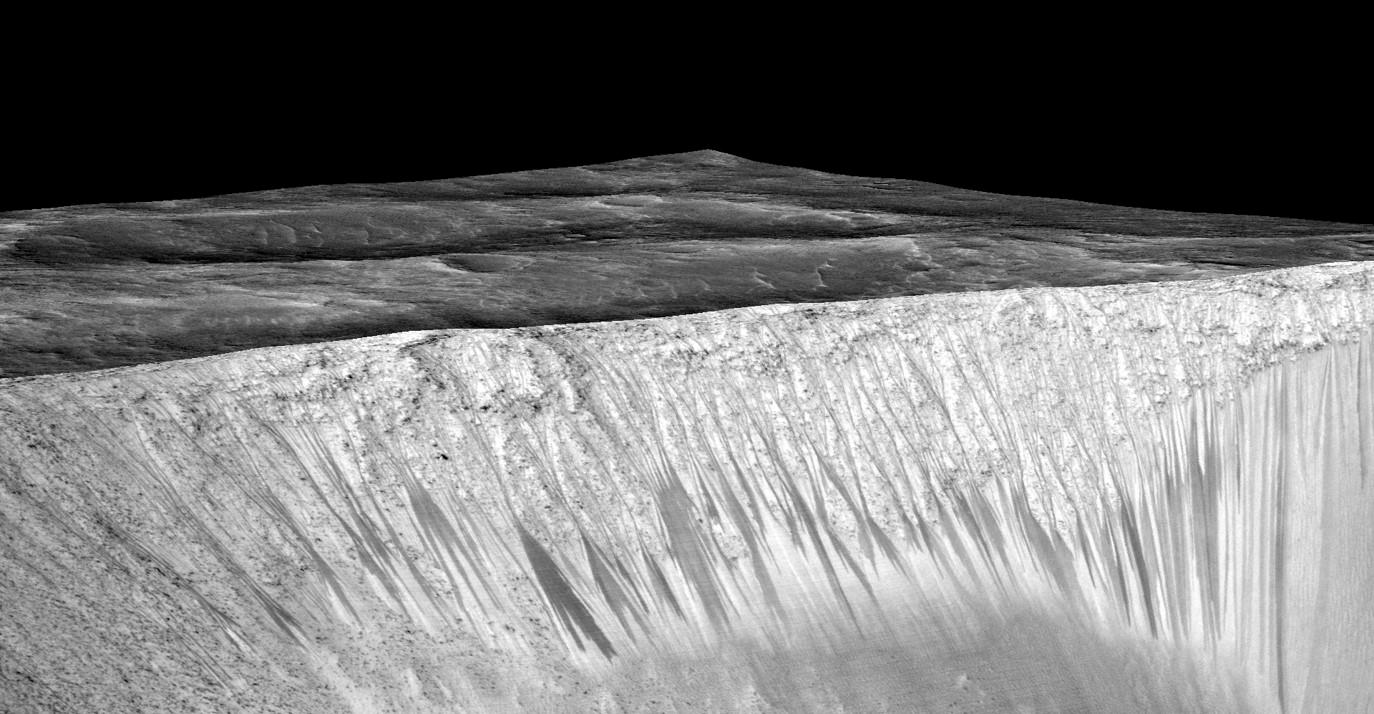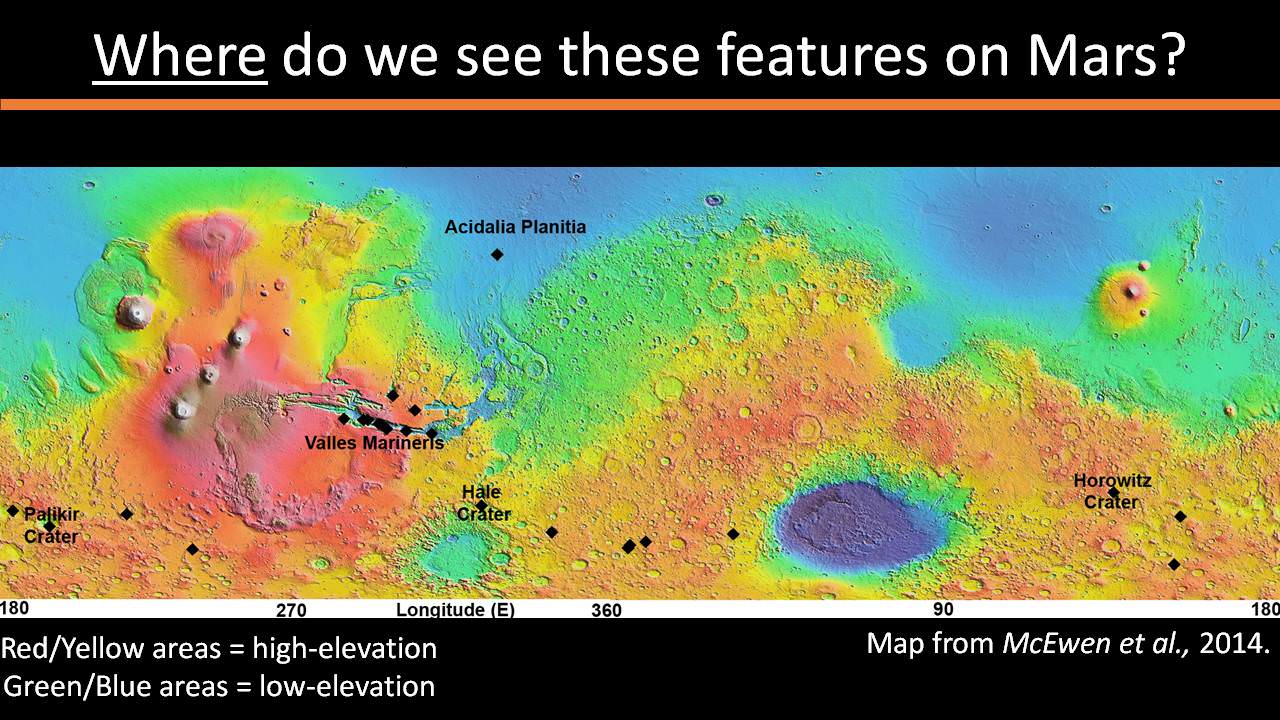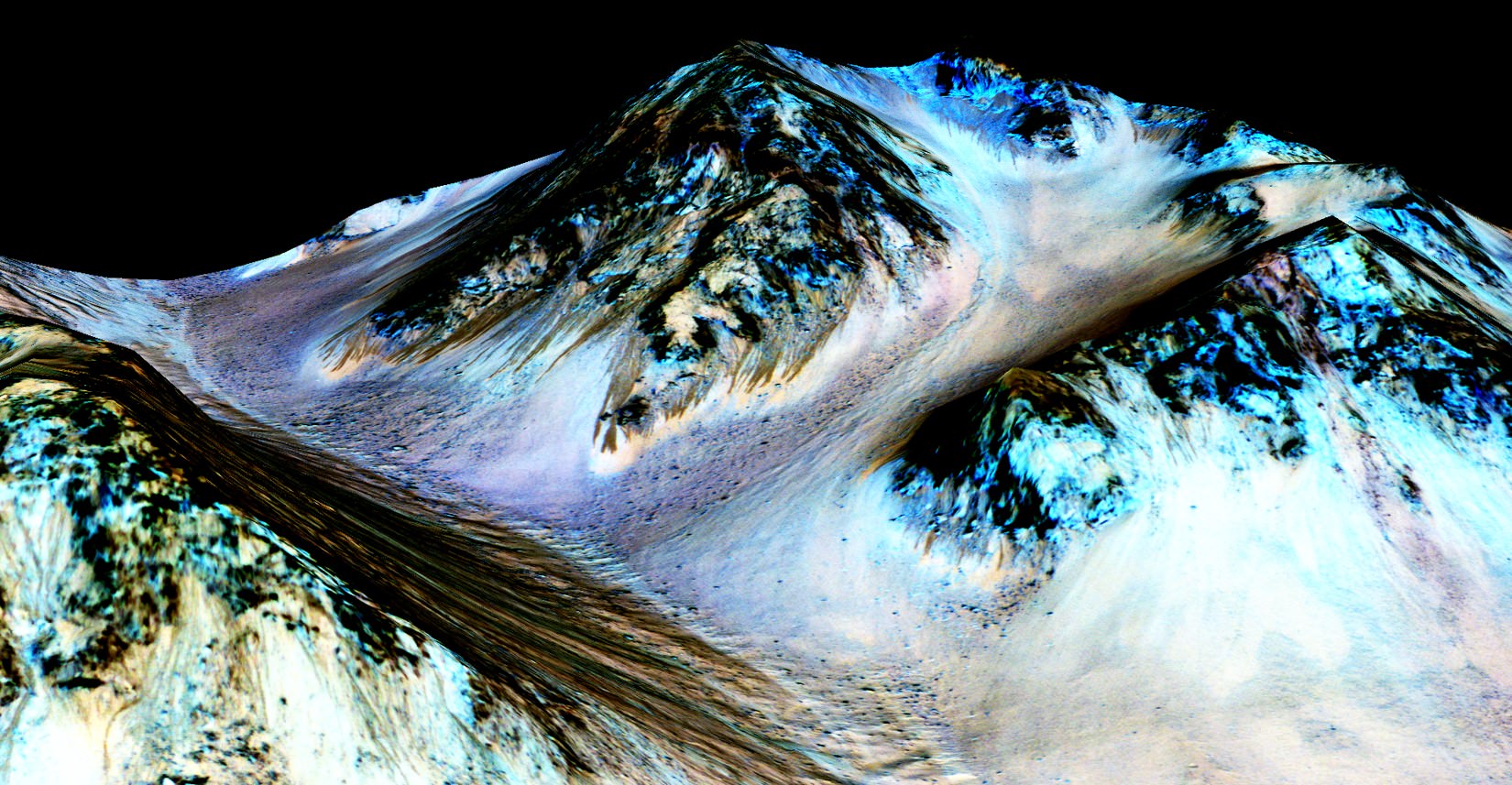These dark, narrow, 100 meter-long streaks called recurring slope lineae flowing downhill on Mars are inferred to have been formed by contemporary flowing water. Recently, planetary scientists detected hydrated salts on these slopes at Hale crater, corroborating their original hypothesis that the streaks are indeed formed by liquid water. The blue color seen upslope of the dark streaks are thought not to be related to their formation, but instead are from the presence of the mineral pyroxene.
The image is produced by draping an orthorectified Infrared-Red-Blue/Green(IRB)) false color image on a Digital Terrain Model (DTM). This model was produced by researchers at the University of Arizona, much like the High Resolution Imaging Science Experiment (University of Arizona). The vertical exaggeration is 1.5.
NASA and Mars planetary scientists announced today (Sept. 28) that salty “liquid water flows intermittently” across multiple spots on the surface of today’s Mars – trumpeting a major scientific discovery with far reaching implications regarding the search for life beyond Earth and bolstering the chances for the possible existence of present day Martian microbes.
Utilizing spectroscopic measurements and imaging gathered by NASA’s Mars Reconnaissance Orbiter (MRO), researchers found the first strong evidence confirming that briny water flows on the Red Planet today along dark streaks moving downhill on crater slopes and mountain sides, during warmer seasons.
“Mars is not the dry, arid planet that we thought of in the past. Today we announce that under certain circumstances, liquid water has been found on Mars,” said Jim Green, NASA Planetary Science Director at NASA Headquarters, at a media briefing held today, Sept 28.
“When you look at Earth, water is an essential ingredient. Everywhere we go where there’s liquid water, whether its deep in the Earth or in the arid regions, we find life. This is tremendously exciting.”
“We haven’t been able to answer the question – does life exist beyond Earth? But following the water is a critical element of that. We now have great opportunities to be in the right locations on Mars to thoroughly investigate that,” Green elaborated.
“Water! Strong evidence that liquid water flows on present-day Mars,” NASA officials tweeted about the discovery.
The evidence comes in the form of the detection of mysterious dark streaks, as long as 100 meters, showing signatures of hydrated salt minerals periodically flowing in liquid water down steep slopes on the Red Planet that “appear to ebb and flow over time.”
The source of the water is likely from the shallow subsurface or possibly absorbed from the atmosphere.

Water is a key prerequisite for the formation and evolution of life as we know it. So the new finding significantly bolsters the chances that present day extant life could exist on the Red Planet.
“Our quest on Mars has been to ‘follow the water,’ in our search for life in the universe, and now we have convincing science that validates what we’ve long suspected,” said John Grunsfeld, astronaut and associate administrator of NASA’s Science Mission Directorate in Washington.
“This is a significant development, as it appears to confirm that water — albeit briny — is flowing today on the surface of Mars.”
“This increases the chance that life could exist on Mars today,” noted Grunsfeld.
The data were gathered by and the conclusions are based on using two scientific instruments – the high resolution imaging spectrometer on MRO known as High Resolution Imaging Science Experiment (HiRISE), as well as MRO’s mineral mapping Compact Reconnaissance Imaging Spectrometer for Mars (CRISM).
The mysterious dark streaks of downhill flows are known as recurring slope lineae (RSL).
They were first detected in 2010 at dozens of sites on the sun facing slopes of deep craters by Lujendra Ojha, then a University of Arizona undergraduate student.
The new finding is highly significant because until today’s announcement, there was no strong evidence that liquid water could actually exist on the Martian surface because the atmospheric pressure was thought to be far too low – its less than one percent of Earth’s.
The flow of water is occasional and not permanent, seasonally variable and dependent on having just the right mix of atmospheric, temperature and surface conditions with salt deposits on Mars.
Portions of Mars were covered with an ocean of water billions of years ago when the planet was far warmer and more hospitable to life. But it underwent a dramatic climate change some 3 billion years ago and lost most of that water.
The RSL with flowing water appear in at least three different locations on Mars – including Hale crater, Horowitz crater and Palikir crater – when temperatures are above minus 10 degrees Fahrenheit (minus 23 Celsius). They appear during warm seasons, fade in cooler seasons and disappear during colder times.
Pure surface water ice would simply sublimate and evaporate away as the temperature rises. Mixing in surface salts lowers the melting point of ice, thereby allowing the water to potentially liquefy on Mars surface for a certain period of time rather than sublimating rapidly away.
“These are dark streaks that form in late spring, grow through the summer and then disappear in the fall,” said Michael Meyer lead scientist for the Mars Exploration Program at NASA Headquarters, at the media briefing.
Years of painstaking effort and laboratory work was required to verify and corroborate the finding of flowing liquid water.
“It took multiple spacecraft over several years to solve this mystery, and now we know there is liquid water on the surface of this cold, desert planet,” said Meyer. “It seems that the more we study Mars, the more we learn how life could be supported and where there are resources to support life in the future.”

Along with the media announcement, the researchers published their findings today in a refereed scientific paper in the Sept. 28 issue of Nature Geoscience.
“We found the hydrated salts only when the seasonal features were widest, which suggests that either the dark streaks themselves or a process that forms them is the source of the hydration. In either case, the detection of hydrated salts on these slopes means that water plays a vital role in the formation of these streaks,” said Lujendra Ojha, now at the Georgia Institute of Technology (Georgia Tech) in Atlanta, and lead author of the Sept. 28 publication in Nature Geoscience.
The scientists “interpret the spectral signatures as caused by hydrated minerals called perchlorates.”
Ojha said the chemical signatures from CRISM were most consistent with the detection of mixtures of magnesium perchlorate, magnesium chlorate and sodium perchlorate, based on lab experiments.
“Some perchlorates have been shown to keep liquids from freezing even when conditions are as cold as minus 94 degrees Fahrenheit (minus 70 Celsius).”
Perchlorates have previously been detected in Martian soil by two of NASA’s surface missions – the Phoenix lander and the Curiosity rover. There is also some evidence that NASA’s Viking missions in the 1970s measured signatures of these salts.
On Earth concentration of perchlorates are found in deserts.
This also marks the first time perchlorates have been identified from Mars orbit.

NASA’s overriding agency wide goal is to send humans on a ‘Journey to Mars’ in the 2030s.
So NASA astronaut Mark Kelly exclaimed that he was also super excited about the findings, from his perch serving as Commander aboard the International Space Station (ISS), where he is a member of the first ever “1 Year ISS Mission Crew” aimed at learning how the human body will adapt to the long term missions required to send astronauts to Mars and back.
“One reason why NASA’s discovery of liquid water on #Mars is so exciting: we know anywhere there’s water on Earth, there’s some form of life,” Kelly tweeted today from on board the ISS, upon hearing today’s news.
The discovery of liquid water on Mars could also be a boon to future astronauts who could use it as a natural resource to ‘live off the land’ for sustenance and to make rocket fuel.
“If going to Mars on my Year In Space, I’d arrive soon to find water! H20 > rocket fuel, which means I could find my way back home too!,” Kelly wrote on his Facebook page.
“When most people talk about water on Mars, they’re usually talking about ancient water or frozen water,” Ojha explained.
“Now we know there’s more to the story. This is the first spectral detection that unambiguously supports our liquid water-formation hypotheses for RSL.”
Stay tuned here for Ken’s continuing Earth and planetary science and human spaceflight news.


That is certainly provocative, Ken. Even if it is only a flow of moisture this is a major advance. The places where the flow is found do not look like inviting places to land or even places to which to send a rover. Shall we send a mountain climber with the first human Mars probe?
How far are these deposits from Curiosity and is it practical for it to drive there or will another mission with a more specialized rover be required?
Spice must flow.
https://s-media-cache-ak0.pinimg.com/736x/77/5b/41/775b4105115a2995c94896d76bee781b.jpg
just look for the worm sign…
So, help me understand this – life comes from dirty salty water? Come to think of it, that is close to what Darwin posited. We can forgive him, he had never seen the inside of a cell. 150 years later, with no explanation of life’s origins on earth, I humbly suggest that scientists first develop a plausible, comprehensive model of naturalistic origins of earth’s life, then we will better understand a potential Martian environment. The only life on Mars is what the earthlings have contaminated it with, intentionally or otherwise.
You don’t understand science. Go back to your book…
Well, yes … the originals written by Frank Herbert were rully excellent, but the followups by Brian H, and Kevin Anderson, were good for the faithful, moi aussi, but not quite up to the master’s standard. Any’ow, is Paul’s interstellar jihad starting even now in our Middle East?? Terraforming Mars could become a Western priority.
Agreed: the later ones are only decent prequels to a fantastic original series.
But if only they HAD written the originals, I think my head wouldn’t have hurt so bad by the end. #greatstory #lessgreatauthor ~_^
Jeffrey, we actually cannot describe for certain the process by which life began on Earth, at least from a scientific standpoint. We do have several scientific theories/hypotheses which remain as yet unproven, however tantalizingly plausible they may appear. I do NOT say that these ideas are necessarily “wrong,” but we must remember that they have not yet been shown to be “fact,” either.
While qedlin’s last sentence is certainly more inflammatory and editorial than it is scientific, we cannot yet scientifically say for certain whether it is false either. There are a multitude of articles, papers, and interview comments from engineers and scientists involved in all areas of interplanetary exploration which all read along the following lines: “Trying to get a mission to a site where ET life may exist” — e.g., one of these recurring slope lineae — “and then testing conclusively for that life, all while not just ensuring but guaranteeing that the site was previously uncontaminated with Terran life/life signs, is a HUGE technical challenge.” This applies whether we are searching the canyons of Mars, the oceans of Europa, or someday the dunes of Arrakis for that matter: in searching for ET life, the “how” is critically important. Terran life presumably will still look like LIFE to our sensors even if we accidentally find it somewhere else (e.g., the snowy crust of Enceladus, or the hydrocarbon seas of Titan), and since we have no idea what uniquely NON-Terran life might look like yet, it’s axiomatic that we also have no way of telling one such kind of life apart from another.
The real tail-kinker is that the problem of “contamination” isn’t strictly limited to Mankind’s activities. If our solar system really has been around for bill-ennia, then there’s nearly as great a chance that Terran life has migrated to Mars via meteorite impact as there is that Barsoomian life has migrated to Earth, a la the alleged “Martian bacteria” found in a certain Antarctic meteorite. This means that even if we DO find some conclusive sign of life on the Red Planet, and we can conclusively rule out human-based contamination… we STILL won’t know for sure where it originally came from! At least, not until we can figure out for sure the scientific origin of such life in the first place.
This leads us back to Q’s point: until we know the scientific “how” behind biogenesis, we will never definitively know why life may appear in one place but not another. Unfortunately, people at this point in the discussion will often scream & shout “Panspermia!” or “Genesis!” depending on their
not sorespective religious viewpoints. However the panspermia hypothesis only pushes the problem further back in time without answering the question, and the Bible’s creation story (among others) says nothing scientific or otherwise about the possibility of life on the other worlds which its deity supposedly created (cf. Heb. 11:3). Thus, even if life did arise apart from a god/ess, panspermia still doesn’t tell us how; if it did not, Scripture still says nothing about where else that life may or mayn’t have been created, nor how it may have migrated since that creation.So since neither viewpoint is of any help to us in this discussion (and since neither hypothesis is scientifically provable at this point in any case), let us therefore return to what we know to be scientific fact rather than resorting to hypothesis or personal opinion: we currently lack a complete understanding of the science of biogenesis. As rational beings, we are therefore left to either throw up our hands and say “I DUNNO” and accept our ignorance, or else keep looking for a scientific answer… the very thing which qedlin suggested we do, albeit in a pointed, editorial way.
So what? it does not matter because if we find life on Mars there IS life on Mars….
Well, but the question then becomes “How did it get there?”
There are a number of possible answers:
A) We brought it from Earth
B) It came from Earth some other way,
C) It came from somewhere else in the universe, and
D) It has no other origin but Mars
At the present time, we have no way of determining which of those might be true, and I think we can agree that bringing life with us, and then saying “hey there’s life on Mars!” is a bit of a cheap way to go.
What came first the Chicken or the Egg?
“Hey let me check your clean room right quick… aww, nope your clean room isn’t clean. Never mind the gum on the bottom of my booties…”
Excellent discussion, Smokey!
I would say it’s more-likely the other way around from what he suggested. If we find life native to Mars, it would potentially be far easier to scientifically test how it came to exist. The massive historical biodiversity of the Earth works against our ability to research the source of terran life. A problem that Mars – barring as-yet unknown past habitability – would not present.
Good point, Dash. As long as we can somehow ensure against cross-contamination, i.e., if we can prove that the life we find is “native to Mars” as you say, then perhaps the traits of such life could end up becoming just the “bio-Rosetta Stone” we need to get at the answer.
My feeling, though, is that without a clearer understanding of how life comes to exist in the first place, that “IF” becomes nearly insurmountable, and your point about our native biodiversity shows the magnitude of the problem. Consider the following hypothetical situation: a sizeable colony of the bacteria which are known to thrive in the briny, anaerobic, super-cooled conditions of our Antarctic are somehow blasted off Earth’s surface by an impact, survive the trip to Mars, and then survive/thrive in the very similar conditions found in the Martian RSL. The descendants of this traveling host are then found via some later mission.
First, does it count as “Martian” life when we find it? In deference to UFOsMOTHER, maybe it does, at that! But second, does finding such life on Mars prove that it came from Mars originally? In this hypothetical case, it certainly does NOT, any more than we can prove scientifically that we (or the Antarctic bacteria!) are native to Earth instead of having been “seeded” here by some ancient alien race/comet’s tail/etc.
Given the sheer variety of Terran life, I’m skeptical that Martian life forms (if any) could show us any signs which will definitively allow us to tell them apart from similarly evolved Earth life. In other words, as we continue to have to expand our definition of the term “life” because of the new varieties found on Earth seemingly every day, what could a Martian life form possibly show us that would “prove” that it had nothing to do with the chain of Terran evolution? I’m sure we could determine differences in “species” between our hypothetical Martian & Antarctic varieties of bacteria, I’m just not at all sure that we could determine their difference in ultimate origin even in our most advanced lab settings — certainly not, using such tests as might be available to a rover!
Learning how life can and cannot start on its own is the only way I think we’ll be able to tell for sure whether or not (if I may paraphrase, qedlin?) “All life in the Sol System is originally Terran.” More importantly in my view, a clearer understanding of bio genesis will tell us if life is a thing which must be made somehow, or if it is something that simply happens. Figure that out, and we will have a much better handle on whether to expect life in unimaginable variety throughout the entire cosmos… or whether we will have to bring it with us as we go.
If water drips more continuously in underground caves and crevices, microbes are likely where there is sufficient protection from radiation. We need rovers and drones that can explore caverns on Mars.
Pretty much any place we find water on Earth we find life that has adapted to the harshest of conditions. Even if life is killed by radiation and/or desiccation upon exposure to Martian surface conditions, it will still likely be recognizable as biological in origin.
Surface sampling rovers are easier to build than spelunking ones and if the deposits are too high, some low tech, low power mortars could knock some down for collection and analysis. Valles Marineris seems to have a nice cluster of sites and might be an interesting place to start looking.
This is incredibly exciting news! If this is what can be seen on the surface, just imagine what goes on underground! Now, if only we could find some geothermal springs… say in the Hellas Plaentia? Yesss!
Wonder if there are any RSL to be found in Mie crater??
A good place to look for water flow with radiation protection for micro life is inside the famous lava tubes on Mars and some of these tubes have open access that may allow a rover to enter my guess is it’s just a matter of time before we find proof of life on Mars.
Just a thought: … The grand world of plants evolved and nurtured animals to help spread and cultivate life. Mankind is the best experiment so far in its attempt to reach out beyond the planet. Can we overcome our primal neurosis of searching for “Mommy and Daddy” and get on with our fundamental destiny to seed the solar system and beyond? Are we to remain so wrapped up in our fears of being “alone” we fail to “contaminate” anything beyond our sphere before pointlessly perishing (or getting reset back to bacteria) in the bump and grind of the cosmos?
A rover in a lava tube will need something besides solar panels. A nuclear power source comes to mind. Which will come first: Man on Mars or nuclear powered rovers with bright headlights?
Curiosity is powered by an RTG https://en.wikipedia.org/wiki/Radioisotope_thermoelectric_generator
which have been used for decades. I doubt Curiosity has headlights, do lasers count?
Speaking of hunting for life, has anyone here at UT seen these? So cool!
Possible underwater rover for Europa, etc.: http://www.jpl.nasa.gov/video/details.php?id=1402
Possible asteroid/comet/KBO explorer:
http://www.jpl.nasa.gov/video/details.php?id=1398